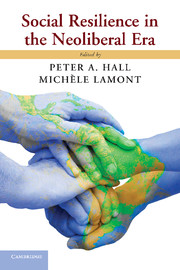Book contents
- Frontmatter
- Contents
- Contributors
- Foreword
- Prologue
- Acknowledgments
- Introduction
- Part I Neoliberalism
- 1 Neoliberalism
- 2 Narratives and Regimes of Social and Human Rights
- 3 Neoliberal Multiculturalism?
- Part II The Social Sources of Individual Resilience
- Part III Social Resilience on a Macro Scale
- PART IV Communities and Organizations as Sites for Social Resilience
- Index
- References
2 - Narratives and Regimes of Social and Human Rights
The Jack Pines of the Neoliberal Era
Published online by Cambridge University Press: 05 May 2013
- Frontmatter
- Contents
- Contributors
- Foreword
- Prologue
- Acknowledgments
- Introduction
- Part I Neoliberalism
- 1 Neoliberalism
- 2 Narratives and Regimes of Social and Human Rights
- 3 Neoliberal Multiculturalism?
- Part II The Social Sources of Individual Resilience
- Part III Social Resilience on a Macro Scale
- PART IV Communities and Organizations as Sites for Social Resilience
- Index
- References
Summary
The Jack pine (pin gris in French) is an icon of Canadian art. It anchors the thin soil of the Canadian Shield even as it is subjected to harsh and howling winds. For some, its bent and twisted form is a sign of deformity. For others, it is a symbol of endurance. The social and human rights regimes are currently much like this Jack pine. Evaluated by some as deformed by neoliberalism, they are dismissed as incapable of promoting the values with which they were originally imbued. For others, these regimes continue to offer social resources to buffer neoliberal challenges. We see them as the equivalent of the Jack pine: through successive encounters with neoliberal institutions and actors, they have evolved, sometimes in dramatic ways, and in the process each developed new ways to anchor capacities for social resilience.
The history of these regimes is important for any consideration of the neoliberal era. International human rights are a central resource for social inclusion and well-being. They promise universal and inalienable protection of individuals and groups’ dignity, key freedoms, and rights to fair treatment as well as participation. Any country's capacity to move these rights from paper to reality provides a resource for social resilience just as lack of respect for basic human rights curtails capabilities and life chances. Similarly, social rights and social protection are a fundamental resource on which people have drawn for more than a century. The direction that each regime has taken in the neoliberal era is thus essential to assessing the resources available to cope with the challenges coming from profound changes in social, economic, and political environments and in the narratives of social inclusion and recognition available to people.
- Type
- Chapter
- Information
- Social Resilience in the Neoliberal Era , pp. 69 - 98Publisher: Cambridge University PressPrint publication year: 2013
References
- 12
- Cited by



